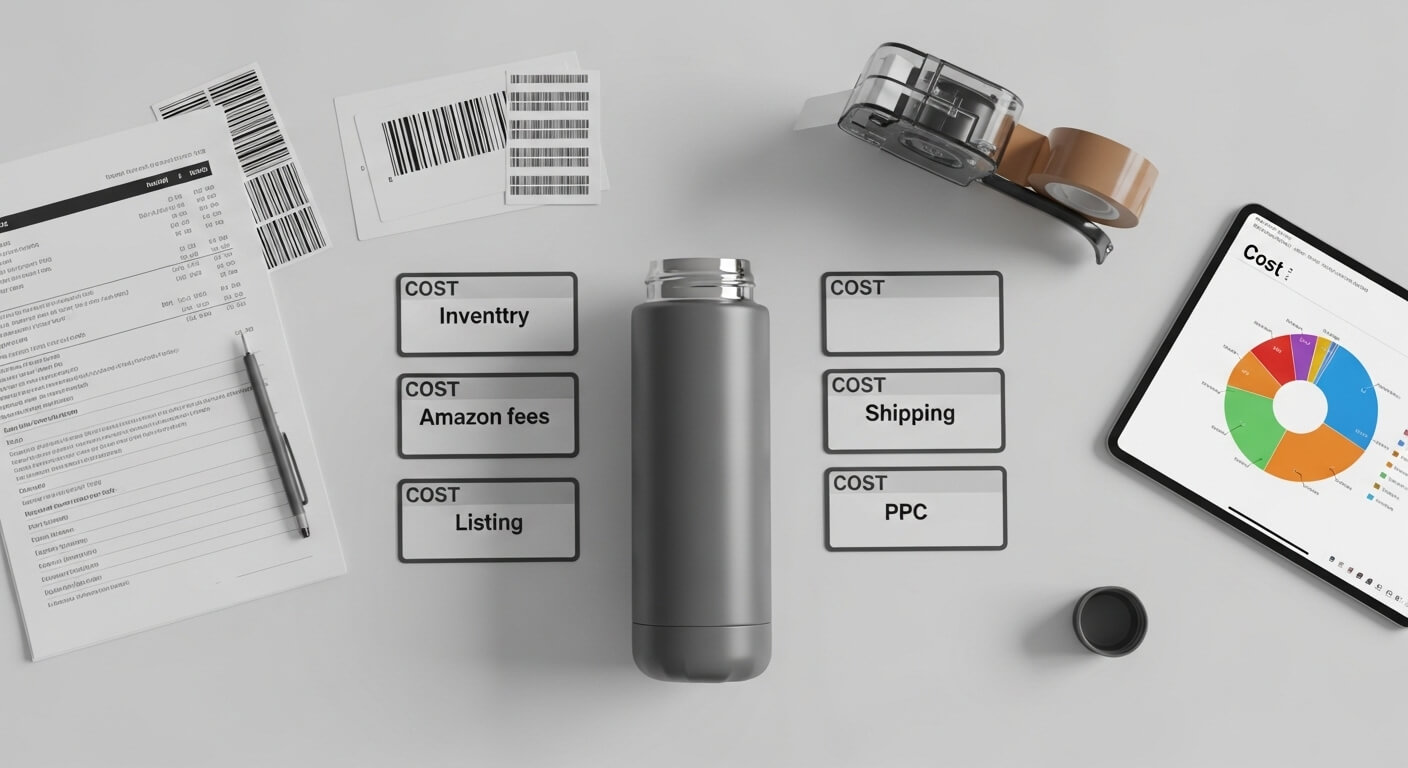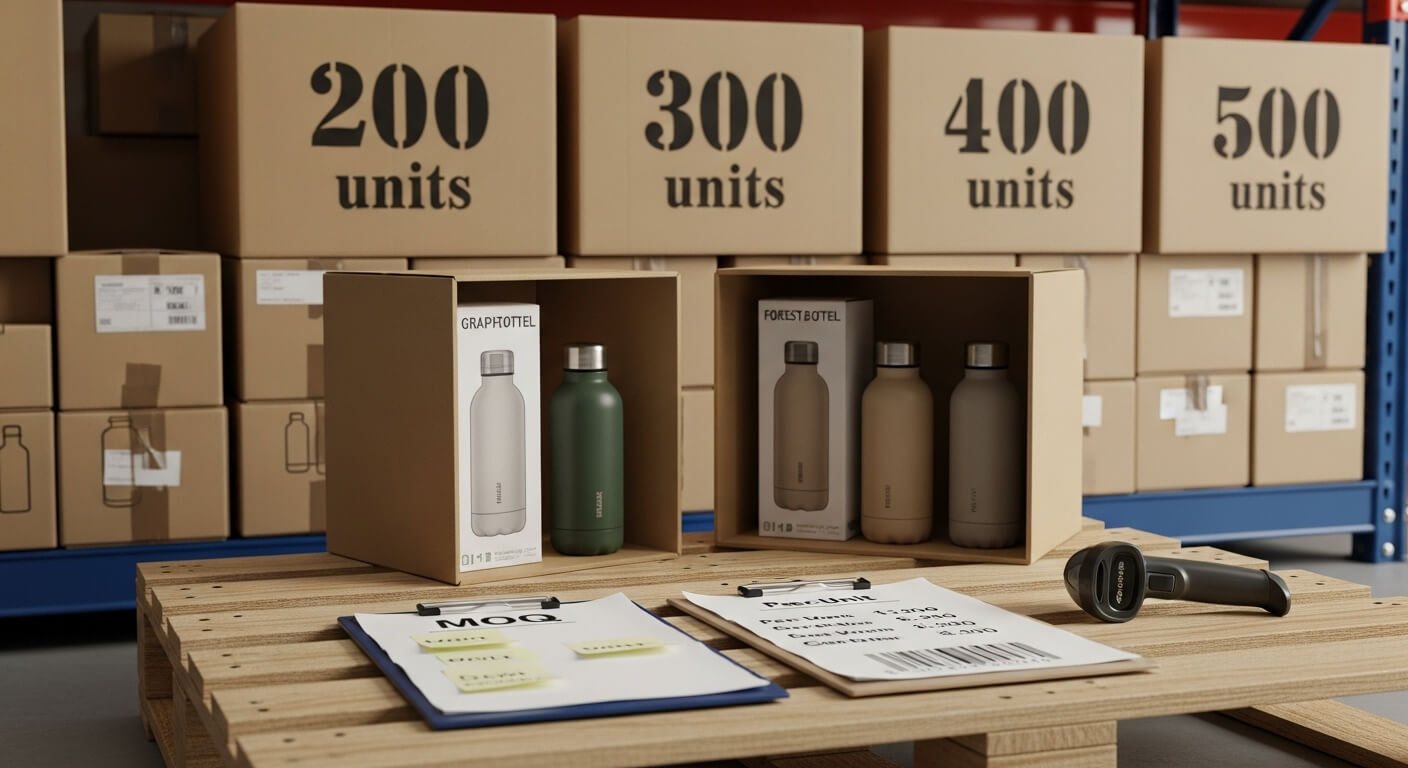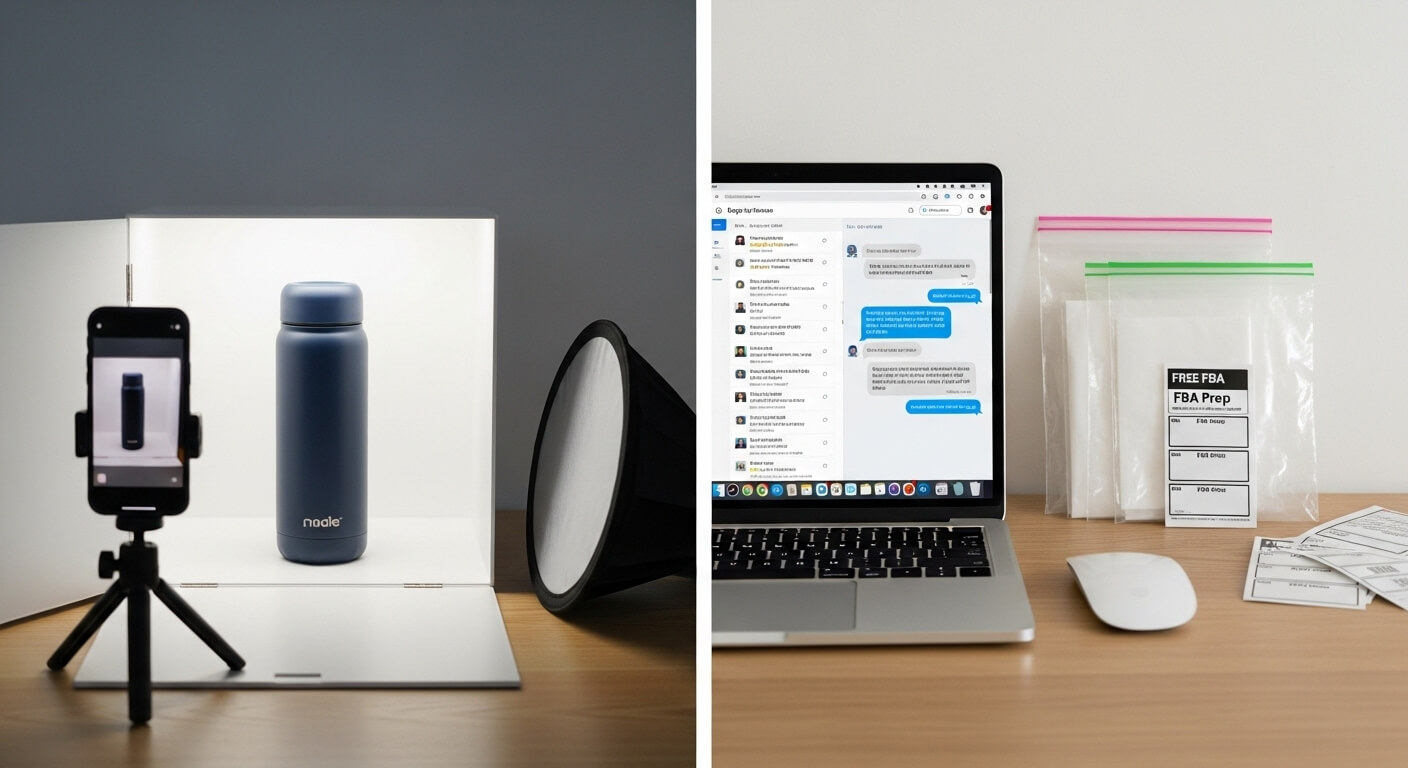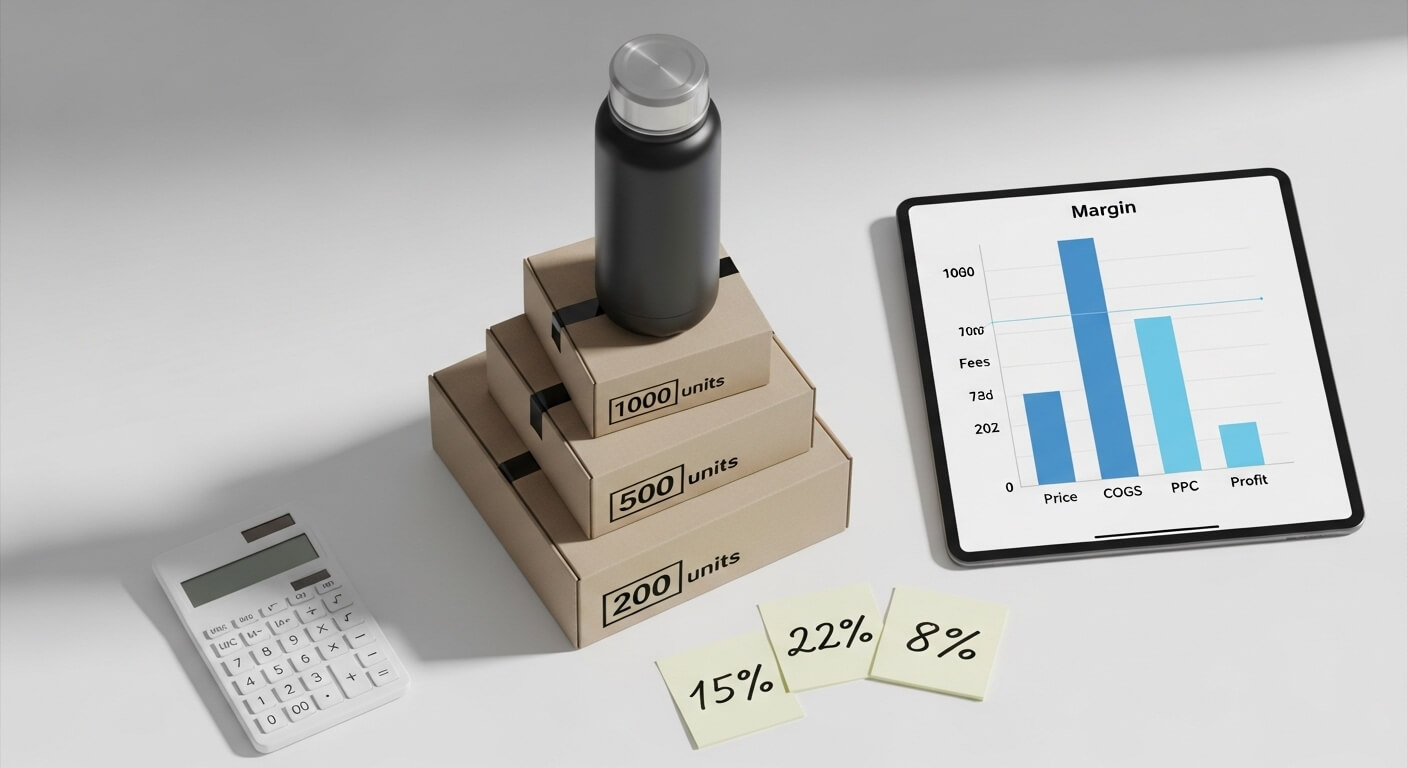
Starting an Amazon FBA water bottle business feels overwhelming. Hidden costs pile up fast. I nearly quit after my first failed launch cost $3,000 more than expected.
The total cost to start selling stainless steel water bottles on Amazon FBA ranges from $1,500 to $5,000. This includes $600-$3,000 for inventory (200-500 units), $300-$800 for shipping, $40/month for Amazon's professional plan, and $200-$1,000 for initial marketing and listing optimization.
Let me break down every cost so you avoid my expensive mistakes. I'll show you the exact numbers from my launches and what really works in 2025.
What Are the Main Startup Costs for Selling Stainless Steel Water Bottles on Amazon FBA?
I learned the hard way that success depends on understanding every expense upfront. Small costs add up to big surprises later.
The five main startup costs are: inventory ($600-$3,000), Amazon fees ($40/month plus 15% per sale), shipping to FBA warehouses ($300-$800), listing optimization ($100-$500), and initial PPC advertising ($200-$1,000). These costs total $1,500-$5,000 for most new sellers.

Breaking Down Each Cost Category
My first mistake was focusing only on product cost. I forgot about the dozens of other expenses that matter just as much.
Inventory Investment Strategy
Your biggest expense will always be inventory. I started with 200 units at $4 each from Alibaba. The total came to $800 plus shipping. This gave me enough stock to test the market without risking everything.
Most suppliers require minimum orders of 200-500 units. Smaller orders cost more per unit. Larger orders tie up too much cash for beginners. I found the sweet spot at 300 units for most launches.
Amazon Platform Costs
Amazon charges two types of fees. The professional selling plan costs $39.99 per month. You also pay 15% of each sale as a referral fee. For a $20 water bottle, that's $3 per sale.
FBA fulfillment fees1 add another $3.50-$5 per unit depending on size and weight. Storage costs $0.87 per cubic foot per month. During peak season (June-September), storage jumps to $6.90 per cubic foot.
Shipping and Logistics Expenses
Getting products from China to Amazon warehouses involves multiple steps. Sea freight costs $200-$400 for small shipments. Air freight runs $400-$800 but arrives faster.
Import duties2 add 10-25% depending on current trade policies. In 2025, tariffs on Chinese steel products remain at 25%. Budget an extra $1 per unit for these costs.
Cost Comparison Table
| Expense Category | Low End | High End | My Experience |
|---|---|---|---|
| Inventory (300 units) | $900 | $1,800 | $1,200 |
| Shipping to FBA | $300 | $800 | $450 |
| Amazon fees (first 3 months) | $120 | $120 | $120 |
| Listing optimization | $100 | $500 | $250 |
| Initial PPC budget | $200 | $1,000 | $500 |
| Miscellaneous | $100 | $300 | $200 |
| Total | $1,720 | $4,520 | $2,720 |
How Much Inventory Should You Start With, and What Does It Cost?
Finding the right inventory level took me three attempts. Too little means stockouts. Too much drains your cash flow before you see profits.
Start with 200-500 units for your first order. This covers 1-3 months of sales while you test demand. Expect to pay $3-$6 per unit from Chinese suppliers, totaling $600-$3,000 for your initial inventory investment.

Calculating Your Optimal Order Quantity
I use a simple formula now. Estimate monthly sales, then multiply by three. This gives you enough buffer for delays and growth.
Supplier Minimum Order Quantities (MOQs)
Most Alibaba suppliers3 require 100-200 unit minimums for stainless steel bottles. Verified suppliers often demand 500+ units. I negotiate by ordering different colors or sizes to meet MOQs.
Quality suppliers charge $4-$6 per unit for 24oz insulated bottles. Unverified suppliers offer $2-$3 but quality suffers. I learned to pay more upfront to avoid returns later.
Inventory Investment Per Unit
Here's what I pay per unit from my current supplier:
- 24oz stainless steel bottle: $4.50
- Custom logo engraving: $0.50
- Packaging and labels: $0.40
- Total per unit: $5.70
Seasonal Demand Considerations
Water bottles sell year-round but peak in spring and summer. I place larger orders in February to catch the fitness resolution crowd. Summer camping season drives another spike in June.
Winter sales drop 30-40% in most markets. I reduce inventory during November-January to avoid storage fees. This timing strategy cut my carrying costs by $200 monthly.
Storage Fee Management
Amazon charges different rates throughout the year. Regular storage costs $0.87 per cubic foot monthly. Peak season (June-September) jumps to $6.90 per cubic foot.
Each water bottle occupies about 0.05 cubic feet. That's $0.04 per unit monthly in off-peak periods. During peak season, it's $0.35 per unit monthly. Plan your inventory timing around these rates.
What Amazon FBA Fees Will You Pay for Water Bottles in 2025?
Amazon fees confused me for months. The fee calculator helps, but you need to understand what drives each cost.
Amazon FBA fees for water bottles include a 15% referral fee, $3.50-$5 fulfillment fee per unit, and $0.87 per cubic foot monthly storage. For a $20 bottle sale, expect total fees of $6-$9, leaving you $11-$14 before advertising costs.

Detailed Fee Breakdown
Amazon's fee structure has five main components. Each impacts your profit margins differently.
Referral Fees by Category
Kitchen & Dining products (including water bottles) carry a 15% referral fee. This applies to your total sale price including tax. For a $20 bottle, you pay $3 in referral fees.
Some categories charge 8% or 45% depending on the product type. Water bottles consistently fall under the 15% Kitchen & Dining rate across all Amazon marketplaces.
FBA Fulfillment Costs
Fulfillment fees depend on size and weight. Standard-size items under 1 pound cost $3.50-$4.50. Items over 1 pound jump to $4.50-$6.
Most 24oz stainless steel bottles weigh 0.8-1.2 pounds. I budget $4.50 per unit for fulfillment. Larger 32oz bottles often exceed 1 pound and cost $5-$6 to fulfill.
Monthly Storage Fee Calculation
| Season | Rate per Cu Ft | Cost per Bottle | Monthly Cost (300 units) |
|---|---|---|---|
| Jan-May | $0.87 | $0.04 | $12 |
| Jun-Sep | $6.90 | $0.35 | $105 |
| Oct-Dec | $0.87 | $0.04 | $12 |
Long-Term Storage Fees
Items stored over 365 days incur additional charges. Amazon bills $6.90 per cubic foot for long-term storage. This penalty applies every six months after the first year.
I avoid long-term fees by monitoring inventory age reports. Any item approaching 10 months gets marked down or removed. This strategy has saved me thousands in penalties.
Fee Optimization Strategies
Smart sellers work around Amazon's fee structure. I use several tactics to minimize costs without hurting sales.
Inbound Placement Service
Amazon charges $0.40-$1.32 per unit for inbound placement. You can save money by shipping to multiple warehouses yourself. I save about $100 per shipment using this approach.
The trade-off is complexity. You need separate shipments to 3-4 warehouses instead of one. For orders under 500 units, I pay the placement fee for simplicity.
How Can You Reduce Costs When Launching Your Water Bottle Business?
I spent $2,000 more than necessary on my first launch. These cost-cutting strategies would have saved me months of profits.
Reduce costs by starting with Amazon's Individual selling plan ($0.99 per sale vs $39.99/month), sourcing from verified suppliers with lower MOQs, using free FBA prep services, taking your own product photos, and timing shipments to avoid peak storage fees.

Smart Sourcing Strategies
Finding the right supplier makes or breaks your margins. I wasted months with cheap suppliers before learning these lessons.
Supplier Verification Process
Always verify suppliers through Alibaba's Trade Assurance program4. Verified suppliers cost 10-20% more but deliver consistent quality. Unverified suppliers seem cheaper but add hidden costs through defects and delays.
I request samples from 3-5 suppliers before choosing. The $50-$100 sample cost pays for itself by avoiding bad partnerships. Look for suppliers with FDA certifications and positive reviews from US buyers.
Negotiating Better Terms
Most suppliers offer discounts for larger orders or repeat business. I negotiate payment terms after establishing trust. Some suppliers accept 30% deposits instead of full prepayment.
Ask about packaging options. Basic poly bags cost $0.10 per unit. Custom boxes add $0.50-$1 but improve unboxing experience. I use poly bags for FBA since Amazon controls the final packaging.
Listing Optimization on a Budget
Professional product photos and listings can cost $500-$2,000. I learned to do most work myself and outsource only complex tasks.
DIY Product Photography
Amazon requires at least six high-quality images. Professional photographers charge $50-$100 per image. I invested $200 in a lightbox setup and learned basic photography.
My DIY photos convert just as well as professional ones. The key is good lighting and clean backgrounds. I shoot lifestyle photos at local gyms and hiking trails for authenticity.
Content Creation Tools
Several tools help create professional listings without hiring agencies:
- Canva Pro ($12/month): Design infographic images
- Grammarly ($12/month): Polish product descriptions
- Answer The Public (free): Research customer questions
- Helium 10 (free plan)5: Basic keyword research
Timing Your Launch
When you launch affects costs significantly. I learned to time everything around Amazon's fee schedule and seasonal demand.
Avoiding Peak Season Fees
Ship inventory to Amazon before May to avoid peak storage fees. I place orders in February for May delivery. This timing captures spring sales while avoiding summer penalty rates.
Black Friday and Q4 drive huge sales but also higher costs. Plan extra inventory for November-December but avoid excess that carries into January.
New Seller Incentives
Amazon offers various programs for new sellers. In 2025, new FBA sellers receive $100 credits and waived inbound placement fees for their first shipment. These incentives can cover 20-30% of your initial costs.
What Are Realistic Profit Margins and Scaling Costs?
Understanding true profitability took me six months of tracking every expense. Many sellers underestimate the real costs of running this business.
Realistic profit margins for water bottles range from 40-60% before advertising costs. After PPC expenses, expect 20-30% net margins. Scaling from 200 to 1,000 units requires an additional $5,000-$10,000 investment plus $500-$1,000 monthly for tools and advertising.

Real-World Profit Analysis
Let me show you the actual numbers from my best-performing water bottle listing. This gives you realistic expectations for your business.
Unit Economics Breakdown
Here's my profit calculation for a $22 water bottle sale:
- Sale Price: $22.00
- Amazon Referral Fee (15%): -$3.30
- FBA Fulfillment Fee: -$4.50
- Product Cost: -$5.70
- Shipping/Duties: -$1.00
- Storage (monthly average): -$0.20
- Gross Profit: $7.30 (33%)
Before advertising, I make $7.30 per unit. PPC costs average $2-$4 per sale during launch phase. Established products need $1-$2 in ads per sale.
Monthly Business Performance
My water bottle business now generates consistent profits. Here's a typical month's performance:
| Metric | Value |
|---|---|
| Units Sold | 150 |
| Gross Revenue | $3,300 |
| Amazon Fees | -$1,170 |
| Product Costs | -$855 |
| PPC Spending | -$450 |
| Net Profit | $825 |
| Profit Margin | 25% |
Scaling Investment Requirements
Growing beyond your initial order requires significant capital. I learned to reinvest profits gradually rather than borrowing money for expansion.
To scale from 300 to 1,000 units monthly, plan these investments:
- Additional Inventory: $5,000-$8,000
- Enhanced PPC Budget: $1,000/month
- Professional Tools: $200/month (Jungle Scout6, Helium 10)
- Improved Photography: $500
- Brand Registration7: $350
- Trademark Filing: $350
Long-Term Profitability Factors
Several factors affect long-term profitability. I track these metrics monthly to maintain healthy margins.
Competition and Market Saturation
The water bottle market becomes more competitive yearly. New sellers enter constantly, driving down prices and increasing advertising costs.
I combat this by focusing on specific niches. Eco-friendly bottles, bottles for specific sports, or bottles with unique features command higher prices and face less competition.
Seasonal Sales Patterns
My sales follow predictable patterns:
- January-February: 80% of summer average (New Year fitness resolutions begin)
- March-May: 120% of average (Spring preparation)
- June-August: 150% of average (Peak outdoor season)
- September-November: 90% of average (Back to school, declining outdoor activity)
- December: 70% of average (Holiday gift season for some, winter lull for others)
Planning inventory around these patterns prevents stockouts during peak periods and reduces storage costs during slow months.
Conclusion
Starting a water bottle business on Amazon FBA costs $1,500-$5,000 upfront but offers 40-60% profit margins with proper planning and execution.
-
Amazon's official FBA profitability calculator provides accurate fee estimates and helps you determine if your product will be profitable before investing money. ↩
-
Current steel import tariff information helps you budget accurately for additional costs that many new sellers overlook when calculating startup expenses. ↩
-
Alibaba's Trade Assurance program protects your orders with escrow services and supplier verification, reducing the risk of fraud when sourcing from overseas. ↩
-
The Trade Assurance guide explains how to verify suppliers and protect your payments, essential knowledge for safe international sourcing. ↩
-
Helium 10's free plan provides basic keyword research and listing optimization tools without adding to your startup costs. ↩
-
Jungle Scout offers comprehensive product research tools that help identify profitable opportunities and estimate market demand. ↩
-
Amazon Brand Registry protects your intellectual property and unlocks additional selling features that can boost sales and prevent counterfeiting. ↩

